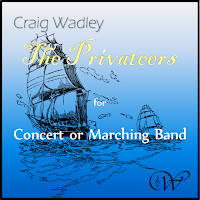The Privateers
The Privateers is a swashbuckling depiction of an oceangoing pirate adventure, presented in the form of a march. The piece starts with a brief fanfare, followed immediately by a rousing melody in the style of an old sea-shanty. Images of sailing upon an endless sea of stars come to mind as a tranquil nocturne is presented, but the peace is shattered as cutlasses and sabers clash in a dogfight sure to end in Davy Jones’ locker! The music swells to a dramatic conclusion as our mighty galleon surges across a stormy sea.
Instrumentation
The Privateers comes with full sets of both concert/stage and marching/field parts, allowing for great flexibility in your performance venues. Contemporary marching bands and drum & bugle corps utilize specialized field percussion which is typically not used in a concert setting. With this piece, the use of "outdoor" percussion (quad toms and a tonal bass drum line) onstage is encouraged, although not required. A single bass drum line is included which may be used instead of (or in addition to) the tonal bass drum line, and the Quad Toms part may be omitted.
A piano part is included, primarily for optional use indoors as a color instrument for the ensemble. However, smaller bands in particular may find it useful for filling out the accompaniment line if instrumentation is limited. Optionally, a very small ensemble of melodic instruments could be used, with the piano acting as a full-fledged accompaniment.
Several optional parts are included, such as Eb and Bb Horn, for ensembles with limited instrumentation. Also, the two "Low Winds" parts should be distributed equally across trombone, baritone/euphonium, and tenor sax players.
Double reed parts are not included. Double these instruments on appropriate parts to suit the needs of your ensemble.
Teaching Points
Meter – The alternation of 6/8 and 4/4 with a constant pulse (rather than a constant 8th note) provides an excellent opportunity to teach your students to shift the subdivision of the beat from triple to duple and back again.
Chromaticism & Accidentals – There is a recurring passage which features the prominent use of secondary dominants, or "circle of fifths" chord motion. Students can learn a few less-than-common accidentals and enharmonics, while also getting a larger lesson in music theory.
LISTEN on YouTube
PURCHASE on SheetMusicPlus




